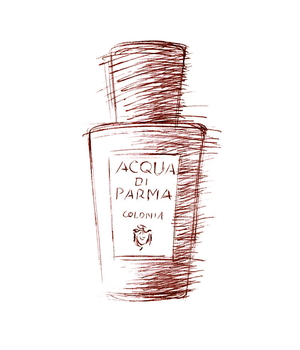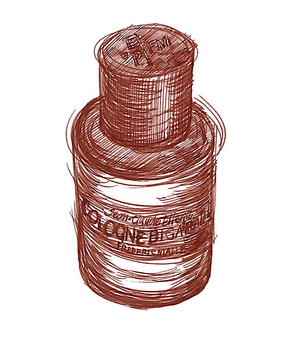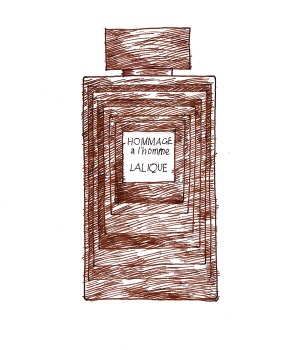Tagged With ‘2001’
Acqua di Parma
Colonia | Colonia Assoluta
14 July, 2015
 Before I start, I have to admit that the Acqua di Parma colognes have never really floated my boat, but very kindly the company have sent me some samples to try, and as it’s one of the most popular men’s fragrances I wanted to explore why that might be.
Before I start, I have to admit that the Acqua di Parma colognes have never really floated my boat, but very kindly the company have sent me some samples to try, and as it’s one of the most popular men’s fragrances I wanted to explore why that might be.
There are lots of things to like about Acqua di Parma Colonia. Its packaging, for starters, is wonderfully elegant: a golden-yellow, linen-textured cardboard tube, which splits exactly in half to reveal the bottle tightly nestled inside.
The bottle itself is a beautifully judged design, in plain glass with gently flared shoulders and a chunky black cap to match. And the typography is lovely: effortlessly stylish, with something of the 1920s about it. The whole package is an object lesson in how to make a product that says ‘classic’ and ‘quality’.
So what about the scent inside? Again, it’s classic and simple – perhaps a little too simple for me. The original Colonia was launched in 1916, and I’m presuming it was always a fresh, citrussy eau-de-cologne, though like pretty much every long-lived fragrance on the market it will almost certainly have been reformulated over the years.
That’s not always a bad thing, and today’s version may well smell more sophisticated than the original; Agua de Colonia by the Spanish brand Alvarez Gomez, for example, may conceivably have been less tinkered with, but by comparison it smells quite crude and harsh.
Not that Colonia has a particularly complex character: it’s intensely lemony when first you spray it on, but as the sharpness of the lemon fades into the background you get the clean, herbal smells of rosemary and lavender. So far so classic eau-de-cologne, but what makes Colonia different is the fact that it’s also blended with rose, which adds an unobtrusively feminine touch – a bit like the artificial jasmine scent at the centre of Eau Sauvage, though not nearly as striking in its effect.
The rose (I think) also makes Colonia smell rather talcum-powderish, which is pleasant enough but comes across as somehow rather old-ladyish – I guess because we associate powdery perfumes with an older generation. It certainly smells clean and fresh, in a soapy kind of way, and perhaps that explains its popularity among men for whom smelling clean and fresh is the main (and often only) purpose of perfume.
Personally I want to smell a bit more interesting than fresh laundry, and my other problem with Colonia is that it doesn’t last: within an hour or two I can hardly smell it on my skin. Again, that may be part of its appeal for men who are a bit nervous about wearing scent of any kind, so horses for courses, I suppose.
After its glory days in the 1920s, the Acqua di Parma company limped along until 1993, when it was bought by three rich Italian businessmen whose money came from Ferrari cars, Tod’s shoes and La Perla underwear. They launched scented candles and the like, but it wasn’t until after the luxury conglomerate LVMH took a stake in 2001 that the Colonia range was extended.
First came Colonia Assoluta in 2003, followed by Intensa in 2007, Essenza in 2010 and Intensa Oud in 2012. I have all of these versions apart from Intensa Oud, and I have to admit that, though I thought I had a fairly sensitive sense of smell, the differences between them are so subtle that I find them almost impossible to tell apart.
Colonia Assoluta was formulated by two of the best-known perfumers around today: Jean-Claude Ellena (creator of Vétiver Tonka, among others) and Bertrand Duchaufour (creator of many unusual fragrances, especially for L’Artisan Parfumeur), which is a bit like getting Debussy and Ravel to compose a duet. The results should be extraordinary, but these two great talents seem to have cancelled each other out: Colonia Assoluta is discreet to the point of invisibility, like a plain grey Hermès jumper.
What Duchaufour and Ellena seem to have done is shuffled a few of the ingredients of the original Colonia about a bit – changing the lavender for jasmine, for example – but it’s all so carefully balanced that the overall effect is almost identical, though you can smell a faint difference after an hour or two. Their work is certainly very subtle and clever, like Gus Van Sant’s frame-by-frame remake of Psycho, but you could argue that it’s equally pointless.
The same conjuring trick, if it’s fair to call it a trick, seems to have been achieved with the Essenza and Intensa versions: in each of them the ingredients are slightly different, but their smell is even less varied than their packaging (Essenza comes in a black tube, but is otherwise, ahem, a carbon copy).
Brilliant or bonkers? Delicious discreet or disappointingly dull? I’ll have to let you compare them for yourself. Maybe my nose isn’t as super-sensitive as it should be, but I’d be interested to hear what other people think. All the same, thank you to Acqua di Parma for letting me give them a try: they certainly look very handsome on my perfume shelf.
Frederic Malle
Cologne Bigarade
10 January, 2015
 Every morning for my breakfast I have tea, toast and home-made marmalade. It’s one of my favourite things, and I love the bittersweet smell of Seville oranges, which only appear in the shops for a couple of weeks around this time of the year.
Every morning for my breakfast I have tea, toast and home-made marmalade. It’s one of my favourite things, and I love the bittersweet smell of Seville oranges, which only appear in the shops for a couple of weeks around this time of the year.
In fact as I sit here writing this post in January, Roy is busy cooking marmalade next door, and the powerful odour of bitter orange (known as bigarade in French) is suffusing the house from kitchen to attic.
So it could hardly be a better time to review Cologne Bigarade, created by the perfumer Jean-Claude Ellena for the French fragrance curator and marketeer, Frédéric Malle (nephew of the film director Louis Malle). Launched in 2001, it was one of the first of the Editions de Parfums Frédéric Malle, and to my mind it’s one of the most immediately appealing and easy to enjoy.
On first – I was going to say ‘glance’, but I suppose I should say ‘spritz’, it smells like a simple but high-quality natural scent, with the exact mix of sweet green freshness and slight bitterness that you get from orange peel and its bitter pith.
You could, I guess, just bottle Seville-orange extract and have done with it – and apparently Jean-Claude Ellena did commission a special new essence for this scent, obtained by molecular extraction. But like all good perfumes Bigarade Cologne is ultimately a clever recreation of what seems, on the surface, like a simple natural scent, using a careful balance of other ingredients to enhance and support the main ingredient.
In this case, Ellena has added a bit of hay and grass – or rather their synthesised essences – which makes the orange even fresher somehow, then subtly underpinned it with a little cedar-wood and rose, adding extra depth and staying-power. You could even say that these extra ingredients suggest the smell of the leaves and the twigs of orange trees, though perhaps that’s going too far.
(Actually, unless you concentrate very hard you can’t really smell them at all; but then we’re so suggestible when it comes to scents that once someone has told you that a particular ingredient is present, you’re more than likely to ‘smell’ it whether it’s actually there or not.)
To me Cologne Bigarade also has a very slight and not unpleasant sweatiness, which (from a short trip to the kitchen and back) is part of the authentic Seville orange smell. In perfume that faint sweatiness is often derived from cumin, and I wonder if there might be a touch of that classic curry spice here too.
Cologne Bigarade is not, perhaps, the most complex perfume on the market, but like most of Jean-Claude Ellena’s fragrances it’s rather more thoughtful and unusual than the general run. Given that he’s also the in-house perfumer for Hermès, it immediately made me think of Hermès’ classic Eau d’Orange Verte, which is also based on the scent of bitter oranges. Though that perfume was originally created by Françoise Caron in 1979, Ellena developed a new version in 2004 called Concentrée d’Orange Verte.
Eau d’Orange Verte is one of my all-time favourite fragrances, yet comparing them side by side, it smells sharper and fresher, but perhaps also slightly less interesting than Cologne Bigarade, which also seems to have much more staying power (a rare quality in a citrus-based cologne, though you can also find it in the fantastic sherbet-lemon Monsieur Balmain).
All the fragrances in the Editions de Parfums Frédéric Malle are expensive, and Cologne Bigarade is no exception, even if its packaging is extremely smart. The heavy, plain-glass bottle has a chunky black cap and comes in a slide-out, black foam-padded box, which in turn slides out (with some effort) of a scarlet card wrapper. If you have money to burn then there’s an even more expensive version called Bigarade Concentrée, which I’ve smelled as a sample and lasts even longer than Cologne Bigarade. The concentrated version also seems to have less of that faint sweatiness about it, which I suspect many people would prefer; I think I do too.
Either way, a fresh but unusual cologne is a wonderful thing to have, so full marks to Jean-Claude Ellena and Frédéric Malle for giving men something a bit different to wear. In a similar vein, though with a very different smell, is Malle’s Geranium Pour Monsieur, which I hope to be able to review before long; watch this space.
Lalique
Hommage à l’homme
29 April, 2014
 Now here’s a tough one. Hommage à l’homme was the first perfume I reviewed whose London launch I attended and whose creator I met, but it’s also the first perfume I reviewed that I didn’t actually enjoy.
Now here’s a tough one. Hommage à l’homme was the first perfume I reviewed whose London launch I attended and whose creator I met, but it’s also the first perfume I reviewed that I didn’t actually enjoy.
On the whole I dislike knocking things, and generally I’d rather not mention fragrances that do nothing for me, but given the number of new launches each year there are bound to be some duds, so if I’m going to recommend scents that appeal to me it seems only honest to come clean about the ones that don’t.
Lalique has a long association with perfume, going back to 1908, when the ground-breaking French perfumer François Coty commissioned René Lalique to design perfume labels for him. Soon Lalique was designing perfume bottles too, and over the decades the company became known for its innovative techniques and the superb quality of its workmanship.
It wasn’t until 1992, though, that Lalique launched a perfume of its own, the imaginatively named Lalique de Lalique. There are now 19 Lalique perfumes to choose from, and Hommage de l’homme is the fourth to be marketed for men.
Hommage de l’homme marks two decades of perfume production, so you’d hope it’d be something special. My problem is that – to me at least – it smells totally generic, and not in a good way. Yes, I can vaguely smell the violets and saffron that we’re told it contains, but they’re completely overpowered by the same toxic chemical smell that spoils so many otherwise promising men’s fragrances.
Ever since I first recoiled from my first sniff of Dior’s Higher in 2001, every other mainstream men’s fragrance seems to have been stuffed full of the same noxious ingredient, which gets right up my nose. It has a harsh, acrid odour, like you get when your computer blows up – a burnt-plastic smell that I wouldn’t want in a toilet cleaner, never mind a perfume I might spray on my skin.
I’ve been puzzling what this secret component could be, if only so I could avoid it – could it be some kind of natural or synthetic extract of black pepper? Would someone like to tell me? Whatever it is, for me it’s a trend that, like Ugg boots, has long outlasted its welcome. Please, perfumers, move on.
PS: Finally someone has identified it: the much-appreciated Grooming Guru, Lee Kynaston – now we know!